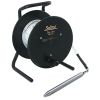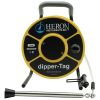Solinst Model 103 Wireline Tag Lines
Features
- Markings are laser etched every 1/4 foot or every 5 centimeters of the cable
- Standard tag weight measures 1.5 lbs and is 3/4" x 12" (included)
- Includes tape guide to protect the wireline from damage on rough edges
- Free ground shipping
- Expedited repair and warranty service
- Lifetime technical support
- More
Overview
The Solinst Model 103 Wireline Tag Line uses a weight attached to a laser marked cable, and is principally designed for use during the installation of monitoring wells. The Tag Line also provides a simple method to measure the depth to the bottom of a well. It is also ideal as a multipurpose marked support cable. Markings are clearly and accurately laser etched every 1/4 foot or every 5 centimeters of the cable. The laser markings allow the cable to run smoothly over the Tape Guide.
Design
The Model 103 Wireline Tag Line uses durable polyethylene coated 1/16"" (1.6 mm) stranded stainless steel wireline with a minimum break strength of 270 lbs (122 kg). It comes in standard lengths of 100 ft. to 1000 ft. (30 m to 300 m). The cable is mounted on a sturdy free-standing reel with a carrying handle, weight holder and brake. The standard stainless steel tag weight is 1.5 lbs (0.68 kg) and measures 3/4" x 1 ft. (19 mm x 30 cm). A narrow tag weight, 1/2" x 1 ft. (13 mm x 30 cm), weighing 0.65 lbs (0.30 kg), is also an option.
Applications
Tag weights have tapered ends to minimize hang-ups during deployment and return to surface, and can be clipped on and off the cable. This allows the use of the reel-mounted marked cable for other uses, such as bailer, or pump, and packer deployment.
- (1) Solinst Model 103 Tag line mounted on reel
- (1) 3/4" x 1' tag weight
- (1) Tape guide
In The News
New map shows significant groundwater depletion in Central California
Groundwater level data collected by a Central California county shows significant drops during the past 12 years, according to a San Luis Obispo Tribune article. Data shows that groundwater has dropped by a minimum of 70 feet from 1997 to 2009 in the Paso Robles area of Central California. In the past four years the areas of most significant decline have expanded north and south. Drought and agricultural withdrawals are the likely culprits for the groundwater decline. Some advocates are calling for more responsible water use by vineyards in the area, while farmers note that the recent drought did not help the situation.
Read MoreSource Water Monitoring in Albany, New York: Tracing Water Quality throughout Tributaries
Thousands of US cities pull their drinking water from natural source waters like reservoirs, rivers, and streams, making overall watershed health a key consideration for water providers. In Albany, New York, the Albany Department of Water and Water Supply delivers drinking water to over 100,000 residents as well as monitors and manages the larger drinking water supply watershed. Hannah Doherty, Environmental Specialist at the Albany Department of Water and Water Supply , spends her days working with a small team to monitor the drinking supply and the connected water bodies. Doherty explains, “We’re the first to encounter the water that ends up being the drinking water.
Read MoreWildfire Prevention in the Sierra Nevada Region with the Yuba Watershed Institute
Though recent wildfires have sparked new conversations about wildfire management and response, groups like the Yuba Watershed Institute have been monitoring the forests and water resources of the Sierra Nevada region for decades, managing approximately 5,000 acres of land with the Bureau of Land Management (BLM) and about 7,000 acres in private land partnerships. The goal of the Institute is to work with local communities and land agencies to improve watershed and forestry management through informed practices and public outreach. The goals of the Yuba Watershed Institute are three-fold: Improve the ability of fire suppression agencies like the California Department of Forestry and Fire Protection ( CAL FIRE ) and the US Forest Service.
Read More


























